Fiber Laser Alloying of Additively Manufactured 18Ni-300 Maraging Steel Part Surface: Effect of Processing Parameters on the Formation of Alloyed Surface Layer and Its Properties
Abstract
:1. Introduction
2. Materials and Methods
2.1. Samples Material and Manufacturing
2.2. Laser Boronizing Process
2.3. Characterization of Boronized Surfaces
3. Results
3.1. Effect of Different Factors on the Formation of Laser-Alloyed Layers
3.1.1. Molten Pool Geometry
3.1.2. Hardness of Laser-Boronized Layers
3.1.3. Cracking of Laser-Boronized Layers and Surface Appearance
3.1.4. Microstructure of Laser-Boronized Layers
3.2. Effect of Laser-Boronizing Parameters on HAZ
3.3. Tribology of Laser-Boronized Surfaces
4. Conclusions
- Fiber laser processing of maraging steel surfaces, pre-coated with amorphous boron paste 0.03–0.6 mm thick and with a continuous laser emitting in melting mode at 300 W power and laser scanning speeds 500–1500 mm/min, allows boronized layers ~280–520 mm thick with hardness from ~490 to ~2200 HK0.2 to be obtained. The microstructure of the alloyed layers varied from hypoeutectic containing low amount of borides phase to mixture of borides (according to X-ray microanalysis: MB, where M is Fe, Co, Ni, and Mo in order of decreasing concentration, and M2B, where M is Fe, Ni, and Co in order of decreasing concentration), and in general was in accordance with the Fe-B phase diagram.
- The molten pool shape and depth changed with preheating temperature; the increase in preheating temperature resulted in deeper and narrower molten pools. With the increasing boron concentration (at thicker boron paste layers and faster laser speeds decreasing the molten pool depth), the shape of the molten pool was changed as well; in general, wider and shallower pools were formed.
- In the entire interval of the process parameters, a heat-affected zone HAZ is formed, consisting of two zones—a narrow (40–130 μm) most softened (~330–430 HK) zone located near the fusion line, and a wider zone (200–650 μm) with hardness increasing as it moves away from the fusion line from ~450 to ~600 HK0.2. The heat input had the greatest influence on the thickness of the zone.
- Two types of cracks were found on doped layers: brittle cracks and chips due to the formation of very hard higher borides, and thermal cracks due to residual tensile stresses, eutectic formation, limited plasticity of boride phases, and an increased coefficient of the thermal expansion of FeB boride. The preheating temperature of 400 degrees was not sufficient to avoid the formation of thermal cracks.
- All boronized samples showed a decrease in wear, with the exception of a series of samples having the lowest hardness at ~ 490 HK0.2. In the hardness range from ~700 to ~1450 HK0.2, there was an improvement in wear resistance (up to 7.5 times) with an increase in hardness. The harder samples showed extensive brittle cracking and surface chipping.
Author Contributions
Funding
Institutional Review Board Statement
Informed Consent Statement
Data Availability Statement
Conflicts of Interest
References
- BS EN ISO/ASTM 52900; Technical Committee AMT/8. Additive Manufacturing—General Principles—Terminology. ISO: Geneva, Switzerland, 2017; pp. 1–30.
- Deckard, C. Method and Apparatus for Producing Parts by Selective Sintering. U.S. Patent 4,863,538, 5 September 1989. [Google Scholar]
- Jamróz, W.; Szafraniec, J.; Kurek, M.; Jachowicz, R. 3D Printing in Pharmaceutical and Medical Applications—Recent Achievements and Challenges. Pharm. Res. 2018, 35, 176. [Google Scholar] [CrossRef] [Green Version]
- Blakey-Milner, B.; Gradl, P.; Snedden, G.; Brooks, M.; Pitot, J.; Lopez, E.; Leary, M.; Berto, F.; Plessis, A. Metal additive manufacturing in aerospace: A review. Mater. Des. 2021, 209, 110008. [Google Scholar] [CrossRef]
- Gradl, P.R.; Teasley, T.; Protz, C.; Katsarelis, C.; Chen, P. Process development and hot-fire testing of additively manufactured NASA HR-1 for liquid rocket engine applications. In AIAA Propuls. Energy Forum, 2021; American Institute of Aeronautics and Astronautics Inc, AIAA: Reston, VA, USA, 2021. [Google Scholar] [CrossRef]
- Gardner, L.; Kyvelou, P.; Herbert, G.; Buchanan, C. Testing and initial verification of the world’s first metal 3D printed bridge. J. Constr. Steel Res. 2020, 17, 106233. [Google Scholar] [CrossRef]
- Lieber, S.C.; Varghese, A.P.; Tarantino, R.; Tafuni, A. Additive manufacturing for plastic extrusion die tooling: A numerical investigation. CIRP J. Manuf. Sci. Technol. 2023, 41, 401–412. [Google Scholar] [CrossRef]
- Herzog, D.; Seyda, V.; Wycisk, E.; Emmelmann, C. Additive manufacturing of metals. Acta Mater. 2016, 117, 371–392. [Google Scholar] [CrossRef]
- Bai, Y.; Yang, Y.; Wang, D.; Zhang, M. Influence mechanism of parameters process and mechanical properties evolution mechanism of maraging steel 300 by selective laser melting. Mater. Sci. Eng. A 2017, 703, 116–123. [Google Scholar] [CrossRef]
- Casati, R.; Lemke, J.N.; Tuissi, A.; Vedani, M. Aging Behaviour and Mechanical Performance of 18-Ni 300 Steel Processed by Selective Laser Melting. Metals 2016, 6, 218. [Google Scholar] [CrossRef] [Green Version]
- Songa, J.; Tanga, Q.; Fenga, Q.; Maa, S.; Setchib, R.; Liub, Y.; Hanb, Q.; Fana, X.; Zhangc, M. Effect of heat treatment on microstructure and mechanical behaviours of 18Ni-300 maraging steel manufactured by selective laser melting. Opt. Laser Technol. 2019, 120, 105725. [Google Scholar] [CrossRef]
- Casalino, G.; Campanelli, S.L.; Contuzzi, N.; Ludovico, A.D. Experimental investigation and statistical optimisation of the selective laser melting process of a maraging steel. Opt. Laser Technol. 2015, 65, 151–158. [Google Scholar] [CrossRef]
- Jägle, E.A.; Sheng, Z.; Kürnsteiner, P.; Ocylok, S.; Weisheit, A.; Raabe, D. Comparison of Maraging Steel Micro- and Nanostructure Produced Conventionally and by Laser Additive Manufacturing. Materials 2016, 10, 8. [Google Scholar] [CrossRef] [Green Version]
- Kürnsteiner, P.; Wilms, M.B.; Weisheit, A.; Barriobero-Vila, P.; Jägle, E.A.; Raabe, D. Massive nanoprecipitation in an Fe-19Ni-xAl maraging steel triggered by the intrinsic heat treatment during laser metal deposition. Acta Mater. 2017, 129, 52–60. [Google Scholar] [CrossRef]
- Jobin, G. How Laser Technology Makes Manufacturing More Sustainable. The Manufacturer 2022 (July/August). Available online: https://www.themanufacturer.com/articles/how-laser-technology-makes-manufacturing-more-sustainable/ (accessed on 18 May 2023).
- Samsonov, G.; Serebriakova, T.; Neronov, V. Boridy; Atomizdat: Moskva, Russia, 1975. [Google Scholar]
- Cuao-Moreu, C.A.; Campos-Silva, I.; Delgado-Brito, A.M.; Garcia-Sanchez, E.O.; Juarez-Hernandez, A.; Diabb-Zavala, J.M.; Hernandez-Rodriguez, M.A.L. Effect of laser surface texturing and boriding on the tribocorrosion resistance of an ASTM F-1537 cobalt alloy. Wear 2023, 523, 204799. [Google Scholar] [CrossRef]
- Günen, A.; Lindner, T.; Karakaş, M.S.; Kanca, E.; Töberling, G.; Vogt, S.; Gök, M.S.; Lampke, T. Effect of the boriding environment on the wear response of laser-clad AlCoCrFeNi high entropy alloy coatings. Surf. Coat. Technol. 2020, 447, 128830. [Google Scholar] [CrossRef]
- Rohrbach, K.; Schmidt, M. Maraging Steels. In ASM Handbook. Volume 1: Properties and Selection: Irons, Steels, and High-Performance Alloys, 10th ed.; ASM International: Materials Park, OH, USA, 1990; pp. 1869–1887. [Google Scholar]
- Rai, A.K.; Paul, C.P.; Mishra, G.K.; Singh, R.; Rai, S.K.; Bindra, K.S. Study of microstructure and wear properties of laser borided Inconel 718. J. Mat. Proc. Technol. 2021, 298, 117298. [Google Scholar] [CrossRef]
- Kulka, M.; Makuch, N.; Pertek, A. Microstructure and properties of laser-borided 41Cr4 steel. Opt. Laser Technol. 2013, 45, 308–318. [Google Scholar] [CrossRef]
- Piasecki, A.; Kulka, M.; Kotkowiak, M. Wear resistance improvement of 100CrMnSi6-4 bearing steel by laser boriding using CaF2 self-lubricating addition. Tribol. Int. 2016, 97, 173–191. [Google Scholar] [CrossRef]
- Bendoumi, A.; Makuch, N.; Chegroune, R.; Kulka, M.; Keddam, M.; Dziarski, P.; Przestacki, D. The effect of temperature distribution and cooling rate on microstructure and microhardness of laser re-melted and laser-borided carbon steels with various carbon concentrations. Surf. Coat. Technol. 2020, 387, 125541. [Google Scholar] [CrossRef]
- Sashank, S.; Dinesh Babu, P.; Marimuthu, P. Experimental studies of laser borided low alloy steel and optimization of parameters using response surface methodology. Surf. Coat. Technol. 2019, 363, 255–264. [Google Scholar] [CrossRef]
- Škamat, J.; Bučelis, K.; Černašėjus, O. Laser Boronizing of Additively Manufactured 18Ni-300 Maraging Steel Part Surface. Materials 2022, 15, 4631. [Google Scholar] [CrossRef]
- Siao, Y.H.; Wen, C.D. Influence of process parameters on heat transfer of molten pool for selective laser melting. Comput. Mater. Sci. 2021, 193, 110388. [Google Scholar] [CrossRef]
- Le, T.N.; Lo, Y.L. Effects of sulfur concentration and Marangoni convection on melt-pool formation in transition mode of selective laser melting process. Mater. Des. 2019, 179, 107866. [Google Scholar] [CrossRef]
- Fuhrich, T.; Berger, P.; Hügel, H. Marangoni effect in laser deep penetration welding of steel. J. Laser Appl. 2001, 13, 178. [Google Scholar] [CrossRef]
- Ahmadi, E.; Ebrahimi, A.R. Welding of 316L Austenitic Stainless Steel with Activated Tungsten Inert Gas Process. J. Mater. Eng. Perform. 2015, 24, 1065–1071. [Google Scholar] [CrossRef]
- Mills, K.C.; Keene, B.J.; Brooks, R.F.; Shirali, A. Marangoni effects in welding. Philos. Trans. R Soc. A Math Phys. Eng. Sci. 1998, 356, 911–926. [Google Scholar] [CrossRef]
- Kamath, C.; El-Dasher, B.; Gallegos, G.F.; King, W.E.; Sisto, A. Density of additively-manufactured, 316L SS parts using laser powder-bed fusion at powers up to 400 W. Int. J. Adv. Manuf. Technol. 2014, 74, 65–78. [Google Scholar] [CrossRef] [Green Version]
- Pashechko, M.; Dziedzic, K.; Jozwik, J. Analysis of Wear Resistance of Borided Steel C45. Materials 2020, 13, 5529. [Google Scholar] [CrossRef]
- Krukovich, M.G.; Prusakov, B.A.; Sizov, I.G. Plasticity of Boronized Layers; Springer International Publishing: Cham, Switzerland, 2016; 369p. [Google Scholar]
- The International Nickel Company, Inc. 18% Ni Maraging Steel Data Bulletin; The International Nickel Company, Inc.: London, UK, 1964. [Google Scholar]
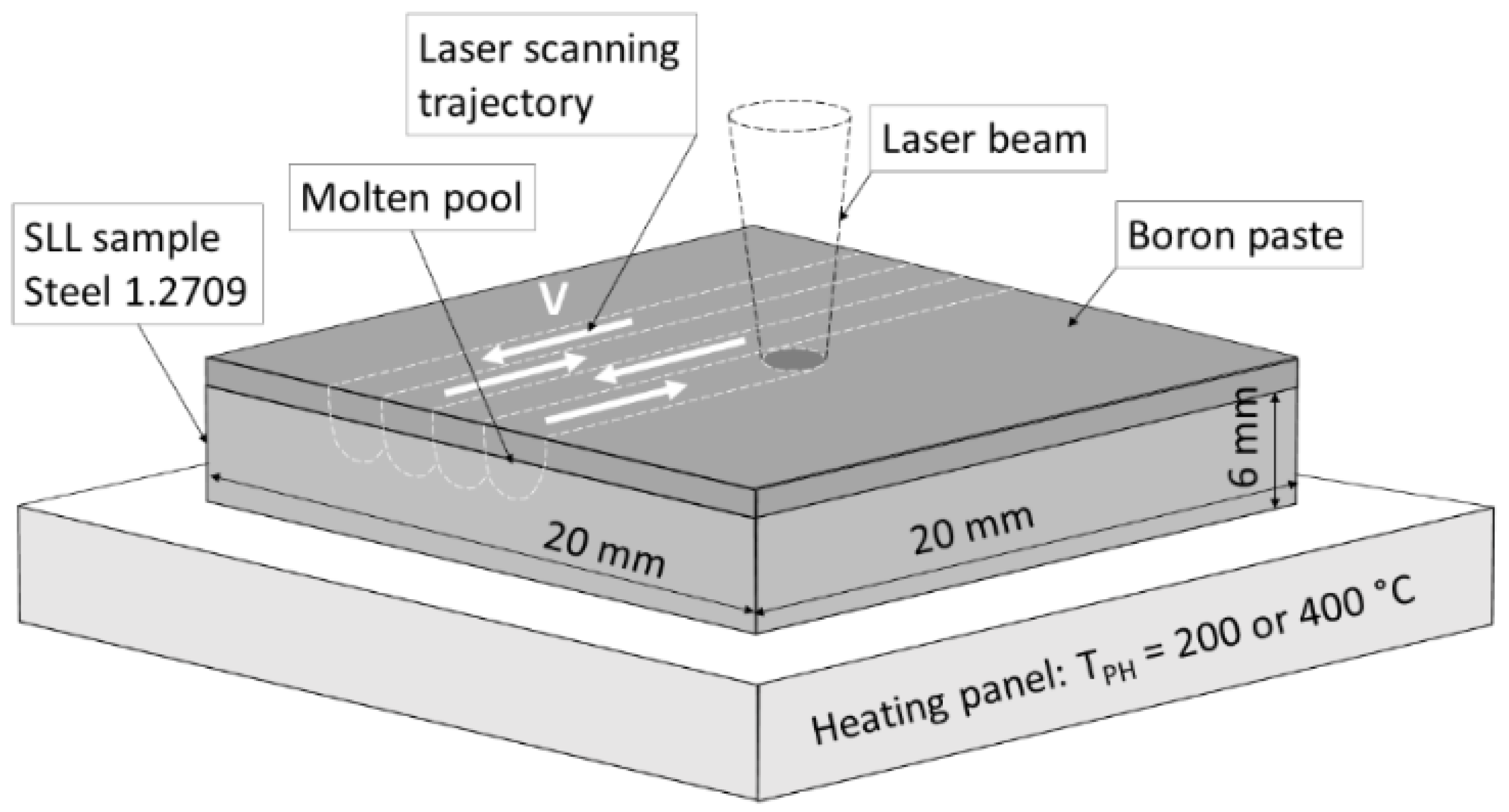

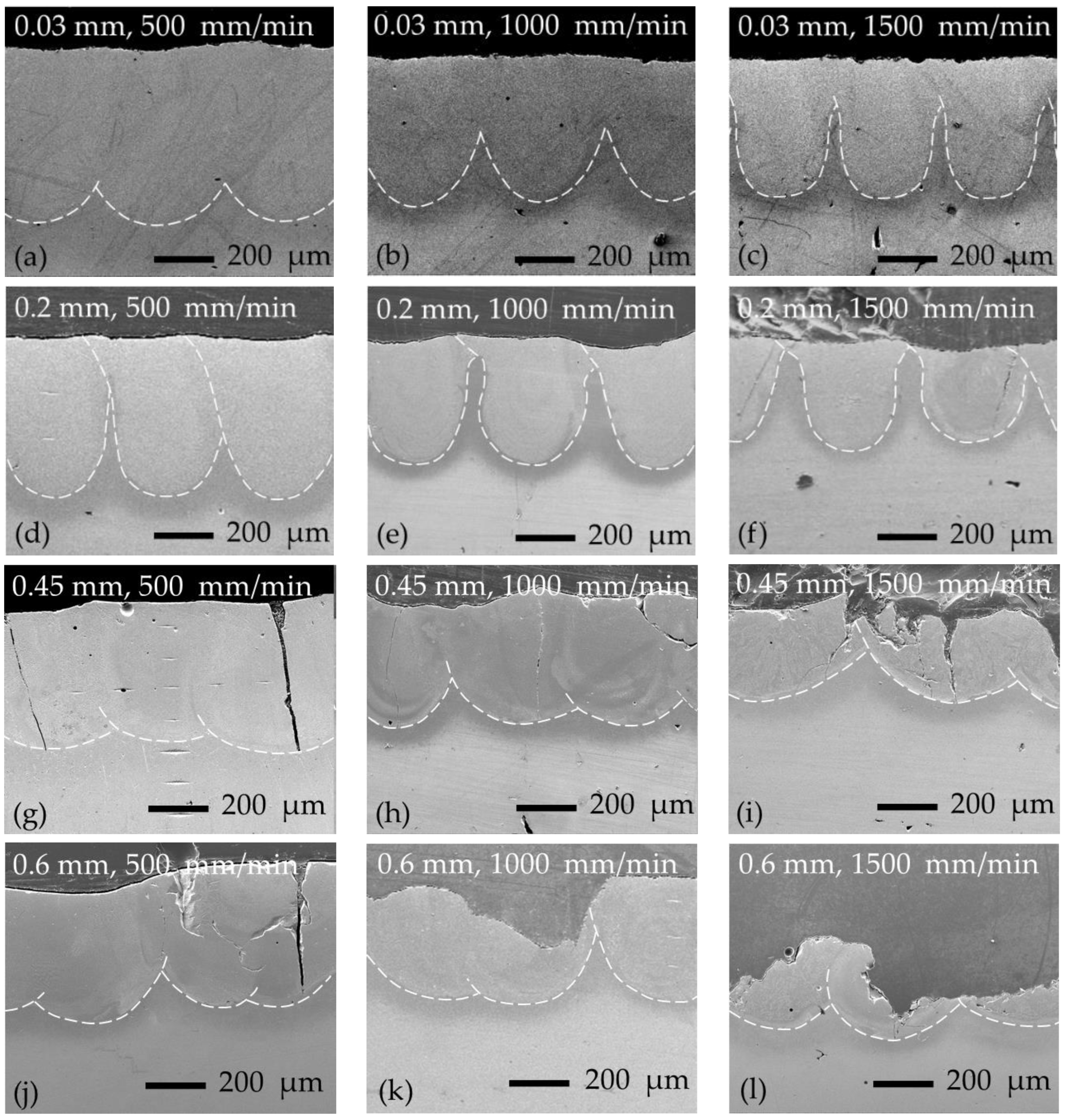
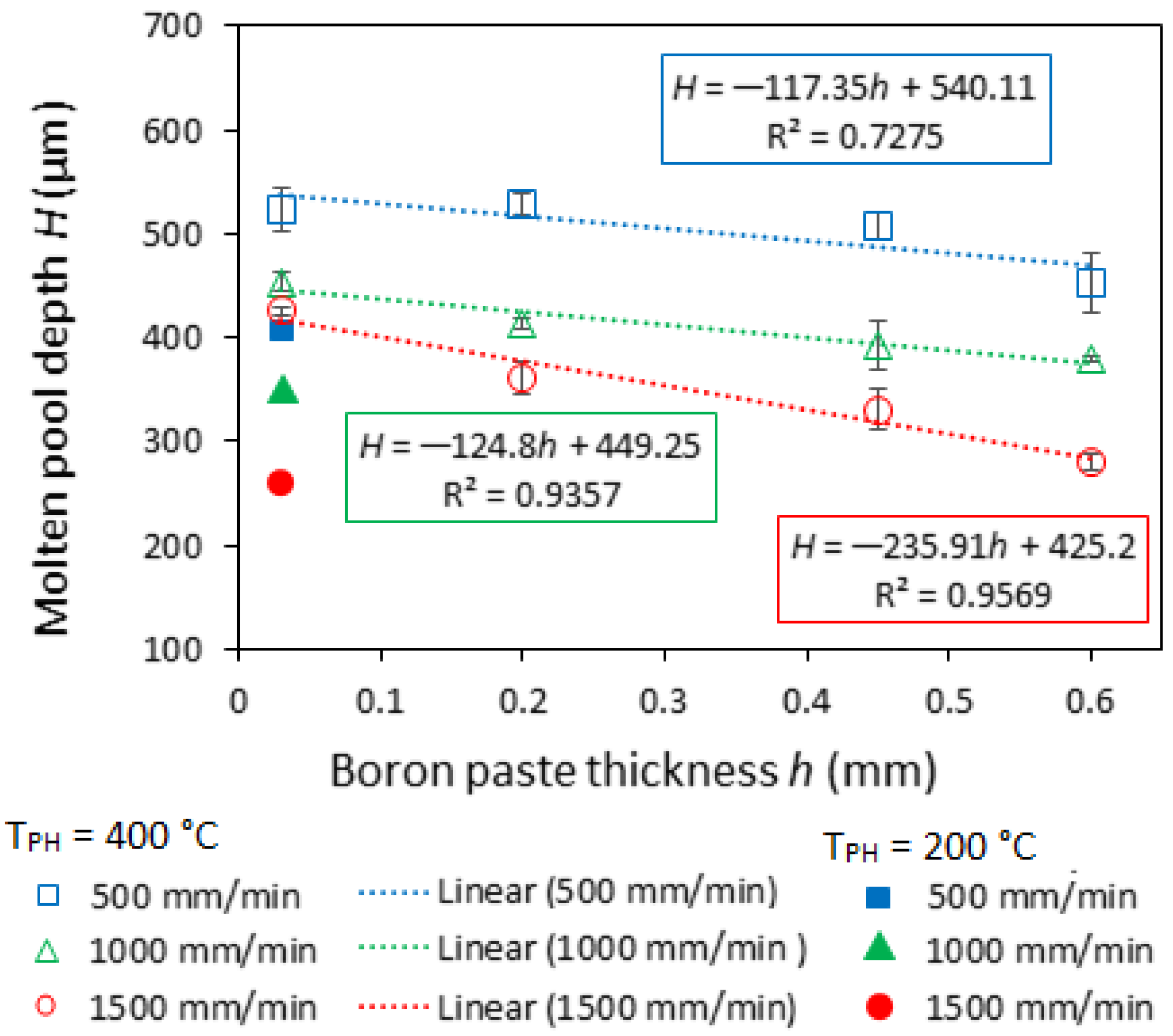
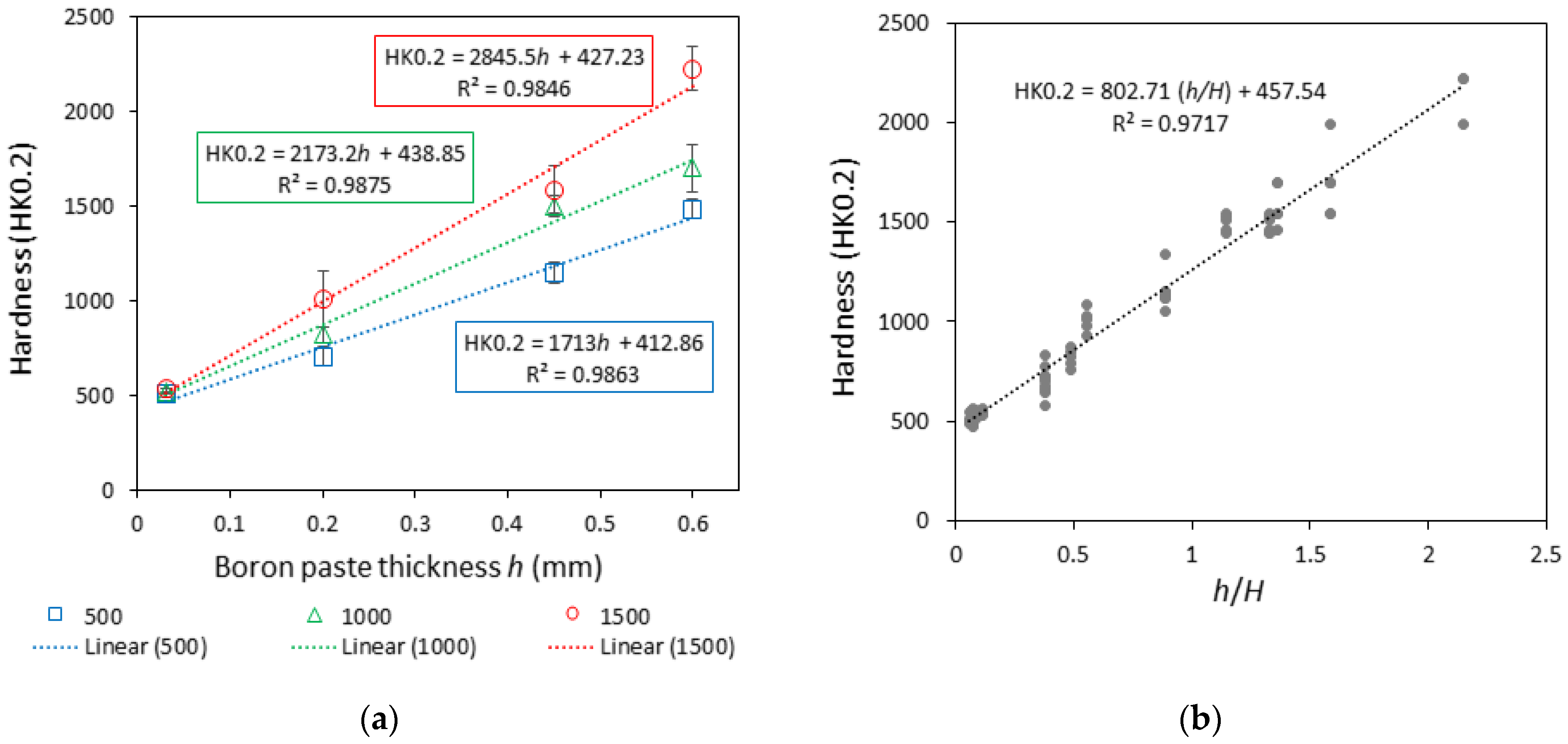
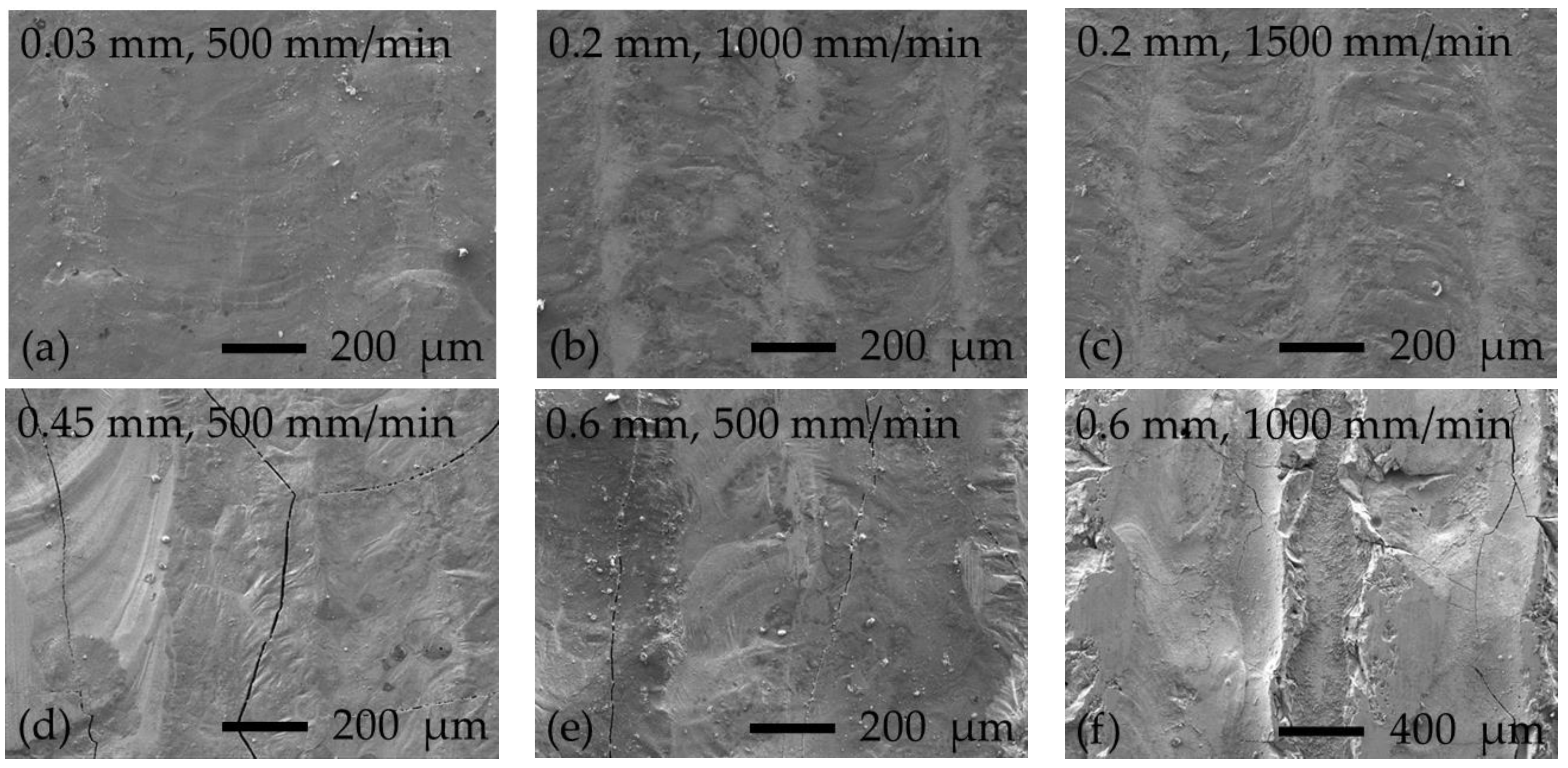
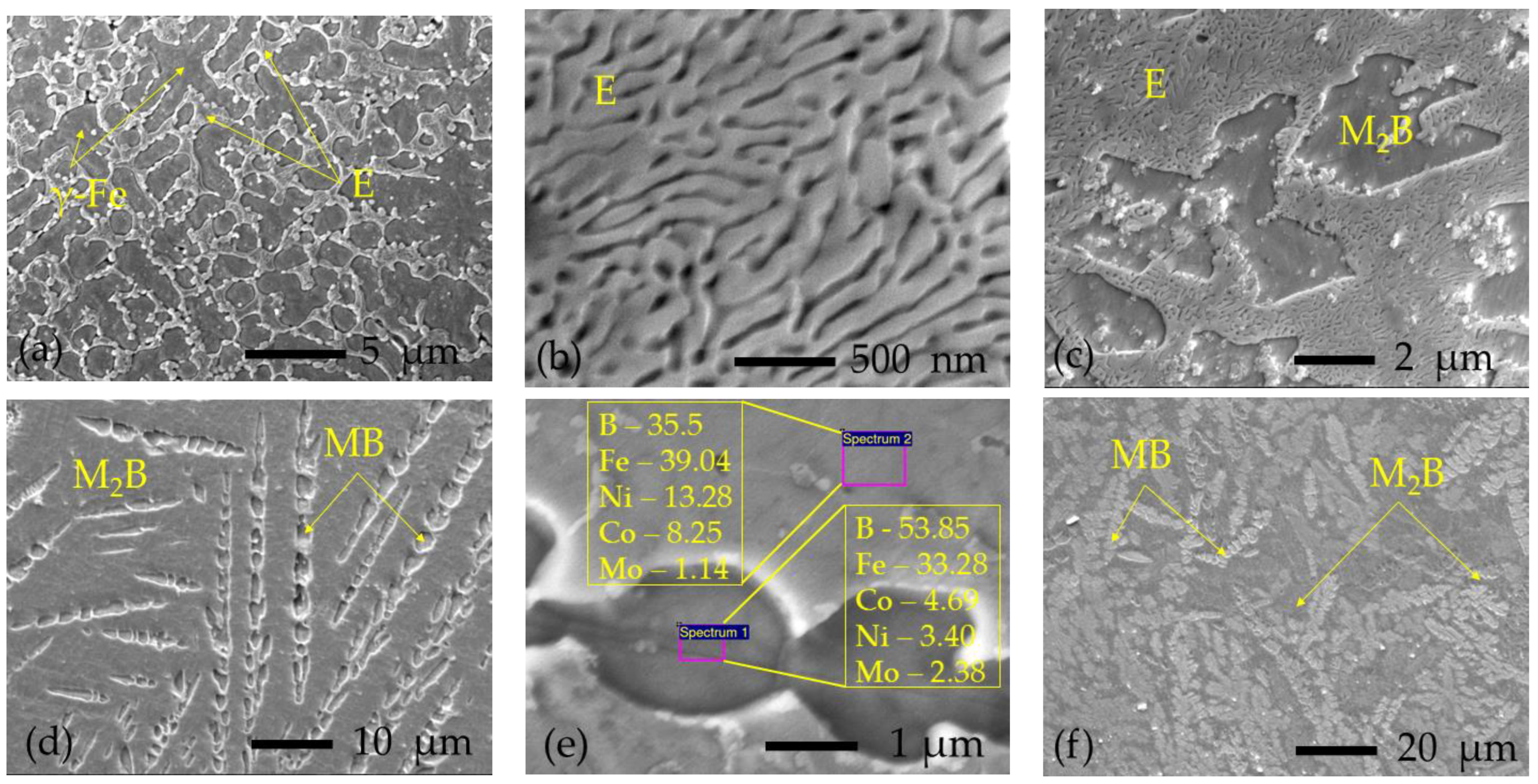
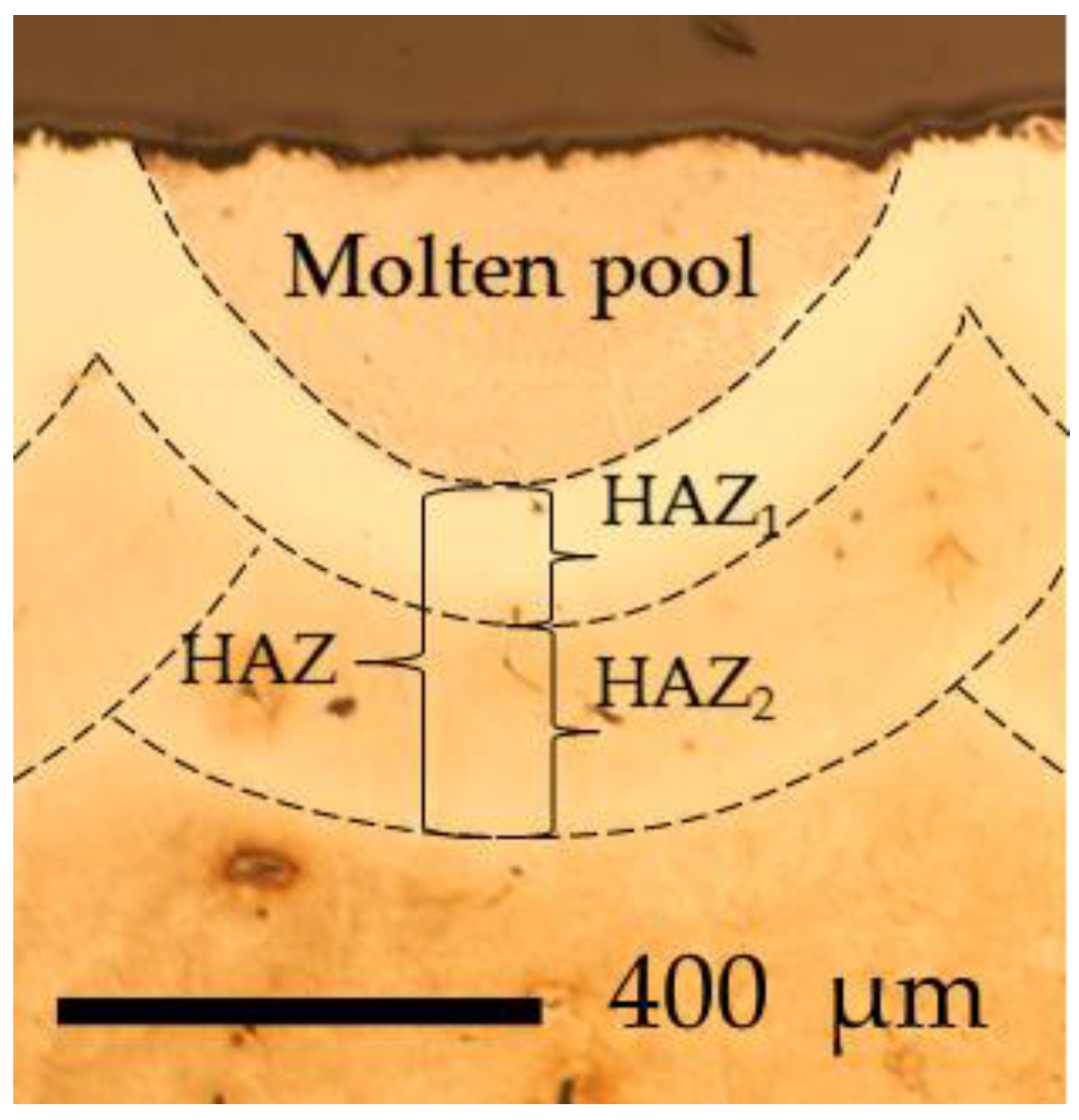
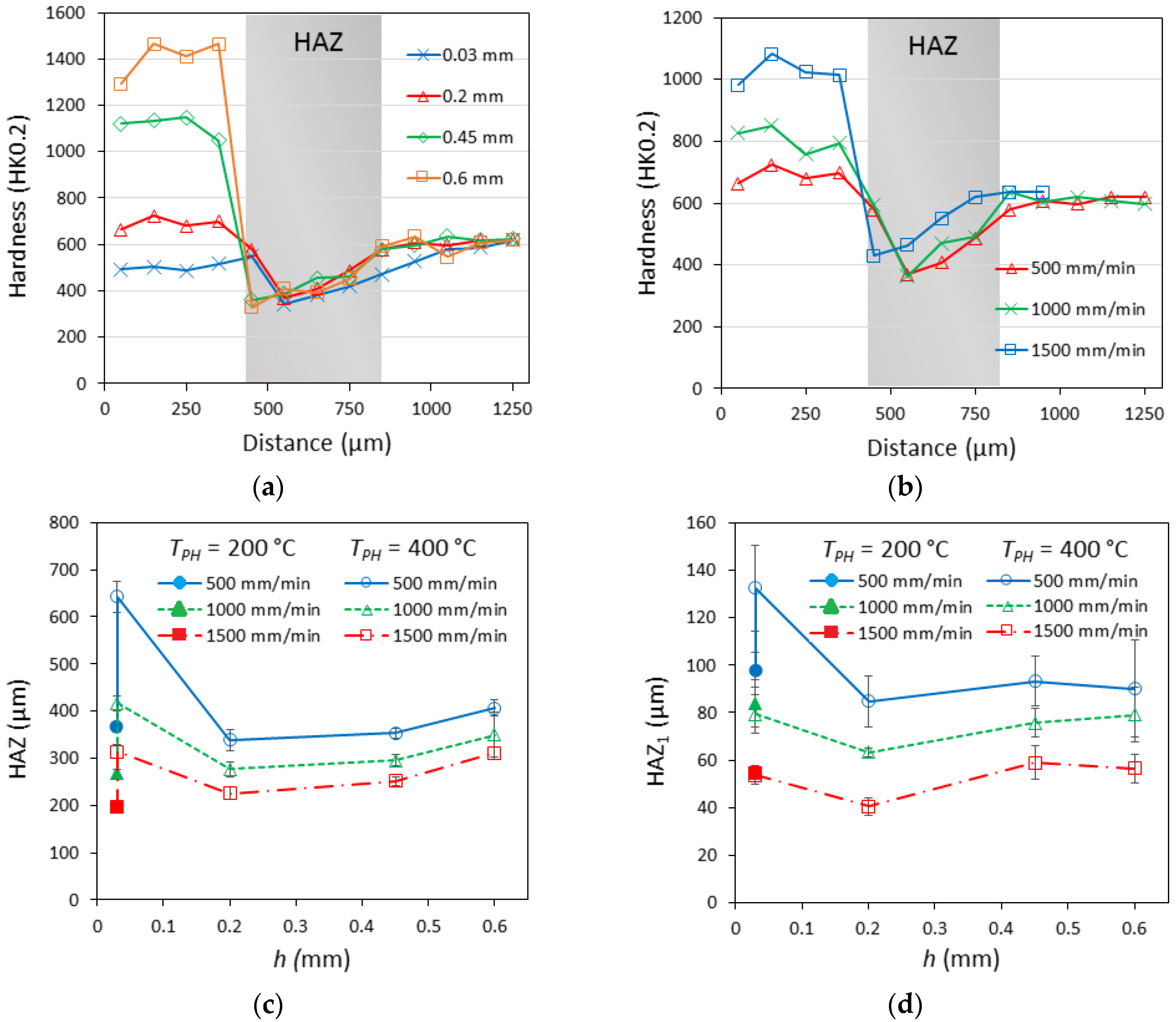
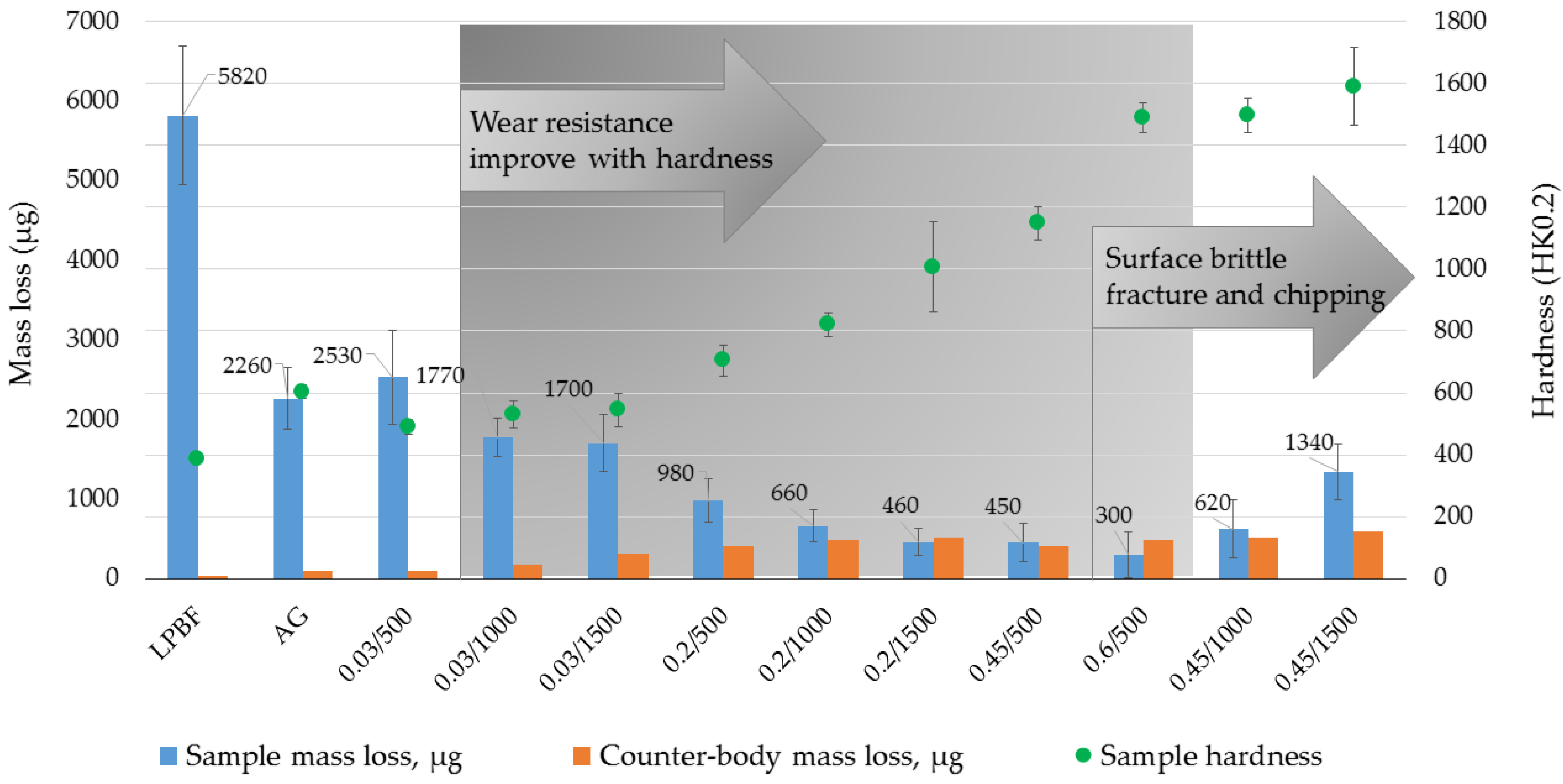

| Source | Base Material | Laser and Processing Parameters 1 | Thickness, Hardness of Alloyed Layer | Phase Composition of Alloyed Layer | Notes |
|---|---|---|---|---|---|
| [20] | Inconel 718 | Ytterbium doped fiber laser, 17.0–28.3 kW/cm2, vL = 3 m/min, boron paste ~250 μm | 274–450 µm, ~1350–1610 HV0.5 | γ-phase, Ni2B, Ni3B, CrB, Cr2B, FeB, Fe2B | Increased roughness and unmelted boron at 17.0–22.6 kW/cm2 |
| [21] | Steel 41Cr4 | CO2 laser, ~37 kW/cm2, vL = 3 m/min, boron paste ~40 μm | ~200 µm, 1100–1600 HV | Martensite, Fe2B, Fe3B | Quick first fatigue crack due to cracks formed during laser processing |
| [22] | Steel 100CrMnSi6–4 | CO2 laser, ~37.26 kW/cm2, vL = 2.88 m/min, boron paste ~60 μm | ~314 µm, 924–1449 HV | Martensite, borocementit, FeB, Fe2B, Fe3B | High hardness exceeding 1400 HV obtained only close to the surface |
| [23] | Steels C20, C45, C90 | CO2 laser, ~8.28 kW/cm2, vL = 2.88 m/min, amorphous boron paste ~60 μm | ~182–239 µm, 867–1037 HV0.05 | α-Fe, FeB, Fe2B, Fe3B | Carbon concentration affects the dilution ratio and hardness |
| [24] | Steel EN25 | CO2 laser, 1.5–2.5 kW, vL = 300–500 mm/min, amorphous boron paste ~250 μm | ~540–900 µm, 1150–1315 HV0.05 | Mixture of iron borides and martensite | Formation of single passes/No cracks reported |
| Thickness of Boron Paste Layer b, mm | Laser Operating Speed V, mm/min | ||
|---|---|---|---|
| 500 | 1000 | 1500 | |
| 0.03 | TPH = 200 °C | ||
| s = 0.7 mm | |||
| 0.03 | TPH = 400 °C | ||
| 0.2 | |||
| 0.45 | s = 0.4 mm | ||
| 0.6 | |||
Disclaimer/Publisher’s Note: The statements, opinions and data contained in all publications are solely those of the individual author(s) and contributor(s) and not of MDPI and/or the editor(s). MDPI and/or the editor(s) disclaim responsibility for any injury to people or property resulting from any ideas, methods, instructions or products referred to in the content. |
© 2023 by the authors. Licensee MDPI, Basel, Switzerland. This article is an open access article distributed under the terms and conditions of the Creative Commons Attribution (CC BY) license (https://creativecommons.org/licenses/by/4.0/).
Share and Cite
Škamat, J.; Bučelis, K.; Černašėjus, O.; Indrišiūnas, S. Fiber Laser Alloying of Additively Manufactured 18Ni-300 Maraging Steel Part Surface: Effect of Processing Parameters on the Formation of Alloyed Surface Layer and Its Properties. Materials 2023, 16, 4732. https://doi.org/10.3390/ma16134732
Škamat J, Bučelis K, Černašėjus O, Indrišiūnas S. Fiber Laser Alloying of Additively Manufactured 18Ni-300 Maraging Steel Part Surface: Effect of Processing Parameters on the Formation of Alloyed Surface Layer and Its Properties. Materials. 2023; 16(13):4732. https://doi.org/10.3390/ma16134732
Chicago/Turabian StyleŠkamat, Jelena, Kęstutis Bučelis, Olegas Černašėjus, and Simonas Indrišiūnas. 2023. "Fiber Laser Alloying of Additively Manufactured 18Ni-300 Maraging Steel Part Surface: Effect of Processing Parameters on the Formation of Alloyed Surface Layer and Its Properties" Materials 16, no. 13: 4732. https://doi.org/10.3390/ma16134732
APA StyleŠkamat, J., Bučelis, K., Černašėjus, O., & Indrišiūnas, S. (2023). Fiber Laser Alloying of Additively Manufactured 18Ni-300 Maraging Steel Part Surface: Effect of Processing Parameters on the Formation of Alloyed Surface Layer and Its Properties. Materials, 16(13), 4732. https://doi.org/10.3390/ma16134732






